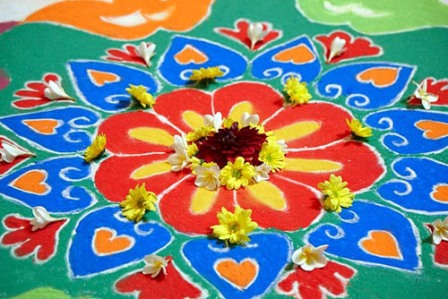
There’s nothing more exciting than celebrating traditions from around the globe, be it Halloween, Christmas, or The Chinese New Year. But I get extra-pumped whenever the dazzling, week-long Hindu festival of Diwali approaches. As I became more and more acquainted with this celebration, I truly fell in love with the art of rangoli, a colourful religious ritual that is creative by nature, and fascinating in form.
Rangoli is an Indian form of art, practised mostly by women, which involves adorning house entrances by making patterns on floors by using coloured powder among other dry material to create a visually striking design that functions as both an offering to the deities, and a warm welcome for guests during the holy celebration.
What I really love about this artform is the magic-like process of creating an elaborate design out of nothing but powder, and the temporary nature of the beautiful creations. I learned that rangoli is mostly drawn using coloured powders, chalk, or rice paste for the main design, and is then embellished with a variety of things including glitter powder, flower petals, sands, and grains like beans and dry pumpkin seeds. Eager to delve deeper into the subject, I went to the Sri Krishna Temple in Ruwi to meet one of the best and most passionate rangoli artists in town.
Paru Negandhi is a creative spirit who’s been practising this artsy profession for more than 20 years, and she was able to explain the evolution of the artform to me. Turns out that back in the day, artists used to burn rice husks and use the white ash to make the rangoli, dying it with natural colour sources like turmeric for yellow and vermilion for red. For lighter shades, they’d mix the plain powder with more vibrant hues to tone it down. The designs were made using hands or sometimes a simple cone.
As times changed, the creative process of rangoli evolved and became more artistic and expressive. Artists now bejewel their powdery art with precious stones, glass materials, laces, and sometimes even jewellery. To this day, these creations still require no brushes, rulers, or canvases, just a steady hand and an empty space on the ground. That said, rangoli is very technique-driven and requires excruciating levels of attention-to-detail.
According to Paru, the whole process begins with a 20-day preparation, which involves selecting designs and importing materials from India (if they’re not available here), before the actual drawing can begin. Her drawings typically take two to four days, depending on the size of the rangoli she is making. The coloured powders or sands are then carefully poured over the drawing — a process which takes a lot of process, and a very steady hand, to master.
I was especially curious about the designs themselves, whose themes range from religious symbolism, to flowers and geometrical shapes, to elaborate portraits that are made into carpet-sized decorations. Depictions of the deities Ganesha and Krishna are popular, as are scenes from ancient stories, which many artists take modern interpretations of. Others go for a more secular aesthetic, drawing inspiration from their favourite personalities, like Steve Jobs. The bottom line is, rangoli art is a totally personal labour of love.
Diwali is incomplete without rangoli, that decorative tradition passed from generation to generation, in which something stunningly beautiful is created with the simplest of materials. As I see it, rangoli is the purest offering of the heart. —[email protected]